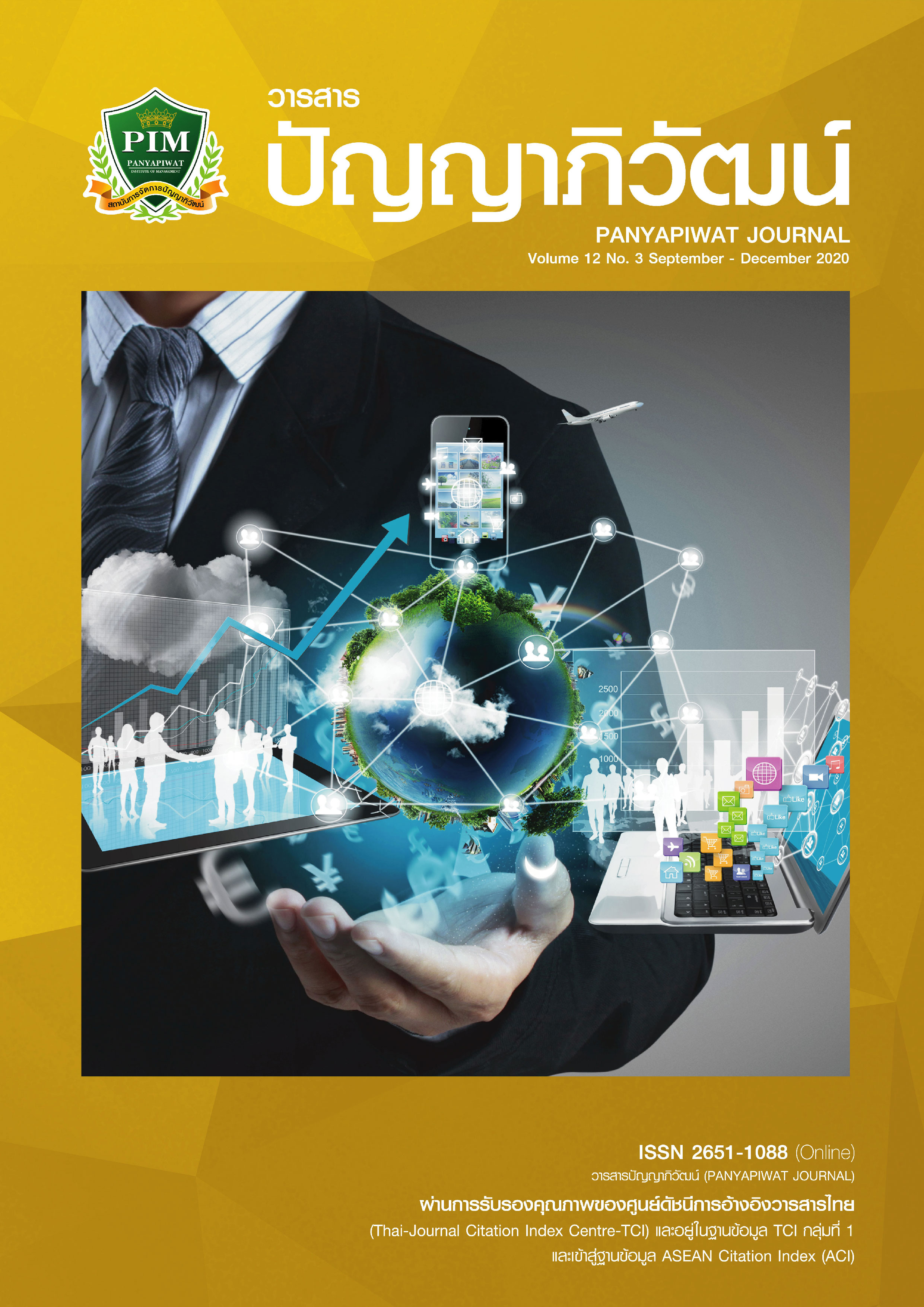อิทธิพลของการมุ่งเน้นตลาด การมุ่งเน้นการเรียนรู้ และความสามารถทางนวัตกรรม ต่อผลการดำ�เนินงานของวิสาหกิจขนาดกลางและขนาดย่อมภาคการบริการ ในเขตภาคตะวันออกเฉียงเหนือของประเทศไทย
Main Article Content
บทคัดย่อ
การวิจัยครั้งนี้มีวัตถุประสงค์เพื่อ 1) ศึกษาความสัมพันธ์เชิงสาเหตุของปัจจัยที่มีอิทธิพลต่อผลการดำเนินงานของวิสาหกิจขนาดกลางและขนาดย่อมภาคการบริการในเขตภาคตะวันออกเฉียงเหนือของประเทศไทย และ 2) ตรวจสอบความสอดคล้องของรูปแบบความสัมพันธ์เชิงสาเหตุของปัจจัยที่มีอิทธิพลต่อผลการดำเนินงานของวิสาหกิจขนาดกลางและขนาดย่อมภาคการบริการในเขตภาคตะวันออกเฉียงเหนือของประเทศไทย กลุ่มตัวอย่างที่ใช้ในการวิจัยคือ ผู้ประกอบการวิสาหกิจขนาดกลางและขนาดย่อมภาคการบริการในเขตภาคตะวันออกเฉียงเหนือของประเทศไทย 600 คน จากการสุ่มตัวอย่างแบบหลายขั้นตอน สถิติที่ใช้ในการวิจัยคือ ค่าร้อยละ ค่าเฉลี่ย ส่วนเบี่ยงเบนมาตรฐาน และการวิเคราะห์รูปแบบความสัมพันธ์เชิงโครงสร้าง
ผลการวิจัยพบว่า 1) ปัจจัยแฝงที่มีอิทธิพลต่อผลการดำเนินงานของวิสาหกิจขนาดกลางและขนาดย่อมภาคการบริการในเขตภาคตะวันออกเฉียงเหนือของประเทศไทย จำนวน 3 ตัวแปร ได้แก่ ตัวแปรการมุ่งเน้นตลาดตัวแปรการมุ่งเน้นการเรียนรู้ และตัวแปรความสามารถทางนวัตกรรม ข้อค้นพบสำคัญคือ วิสาหกิจขนาดกลางและขนาดย่อมภาคการบริการควรให้ความสำคัญกับการมุ่งเน้นการเรียนรู้มากที่สุดโดยปัจจัยที่มีอิทธิพลทางตรงสูงที่สุดคือ ปัจจัยด้านการมุ่งเน้นการเรียนรู้ ส่วนปัจจัยที่มีอิทธิพลทางอ้อมสูงที่สุดคือ ปัจจัยการมุ่งเน้นตลาด ปัจจัยที่มีอิทธิพลรวมสูงที่สุดคือ ปัจจัยการมุ่งเน้นการเรียนรู้ และ 2) ผลการตรวจสอบความสอดคล้องของรูปแบบความสัมพันธ์เชิงสาเหตุพบว่า รูปแบบมีความสอดคล้องกลมกลืนกับข้อมูลเชิงประจักษ์โดยมีค่า X2 = 67.151, df =52, X2/df = 1.291, P-value = .077, GFI= .985, CFI = .998, RMSEA = .022 เมื่อพิจารณาค่าสัมประสิทธิ์การพยากรณ์พบว่า มีค่าระหว่าง .584 ถึง .918 โดยปัจจัยการมุ่งเน้นการเรียนรู้มีค่าสัมประสิทธิ์การพยากรณ์มากที่สุด และปัจจัยแฝงแต่ละตัวร่วมกันพยากรณ์รูปแบบความสัมพันธ์เชิงสาเหตุได้ร้อยละ 77.6
Article Details
“ข้าพเจ้าและผู้เขียนร่วม (ถ้ามี) ขอรับรองว่า บทความที่เสนอมานี้ยังไม่เคยได้รับการตีพิมพ์และไม่ได้อยู่ระหว่างกระบวนการพิจารณาลงตีพิมพ์ในวารสารหรือแหล่งเผยแพร่อื่นใด ข้าพเจ้าและผู้เขียนร่วมยอมรับหลักเกณฑ์การพิจารณาต้นฉบับ ทั้งยินยอมให้กองบรรณาธิการมีสิทธิ์พิจารณาและตรวจแก้ต้นฉบับได้ตามที่เห็นสมควร พร้อมนี้ขอมอบลิขสิทธิ์บทความที่ได้รับการตีพิมพ์ให้แก่สถาบันการจัดการปัญญาภิวัฒน์หากมีการฟ้องร้องเรื่องการละเมิดลิขสิทธิ์เกี่ยวกับภาพ กราฟ ข้อความส่วนใดส่วนหนึ่งและ/หรือข้อคิดเห็นที่ปรากฏในบทความข้าพเจ้าและผู้เขียนร่วมยินยอมรับผิดชอบแต่เพียงฝ่ายเดียว”
เอกสารอ้างอิง
Apirungruengsakul, N. & Pasunon, P. (2020). Marketing innovation driven to E-commerce.
Panyapiwat Journal, 12(1), 1-14. [in Thai]
Baker, W. E. & Sinkula, J. M. (1999). The synergistic effect of market orientation and learning
orientation on organizational performance. Journal of the Academy of Marketing Science,
(4), 411-427.
Beneke, J., Blampied, S., Dewar, N. & Soriano, L. (2016). The impact of market orientation and
learning orientation on organizational performance. Journal of Research in Marketing and
Entrepreneurship, 18(1), 90 – 108.
Calantone, R. J., Cavusgil, S. T. & Zhao, Y. (2002). Learning orientation, firm innovation
capability and firm performance. Industrial Marketing Management, 31(6), 515-524.
Celuch, K. G., Kasouf, C. J. & Peruvemba, V. (2002). The effects of perceived market and
learning orientation on assessed organizational capabilities. Industrial Marketing
Management, 3(16), 545-554.
Decker, M., Schiefer, G. & Bulander, R. (2006). Specific Challenges for Small and Medium-sized
Enterprises (SME) in M-Business. Proceedings of the International Conference on E-Business
(ICE-B 2006) (pp. 169-174). United States: Scimago Institutions Rankings.
Fang, S., Chang, E., Ou, C. & Chou, C. (2014). Internal market orientation, market capabilities and
learning orientation. European Journal of Marketing, 48(1/2), 170-192.
Hair, J. F., Black, W. C., Babin, B. J. & Anderson, R. E. (2010). Multivariate Data Analysis (7th ed.).
New York: Pearson Prentice-Hall.
Jimenez, D. J., Valle, R. S. & Espallardo, M. S. (2008). Fostering innovation the role of market orientation and organizational learning. European Journal of Innovation Management, 11(3), 389 – 412.
Kajalo, S. & Lindblom, A. (2015). Market orientation, entrepreneurial orientation and business
performance among small retailers. International Journal of Retail & Distribution Management, 43(7), 580-596.
Keskin, H. (2006). Marketing orientation, learning orientation, and innovation capabilities in SMEs:
An extended model. European Journal of Innovation Management, 9(4), 394-417.
Kohli, A. K. & Jaworski, B. J. (1990). Market orientation: The construct, research propositions, and
managerial implications. Journal of Marketing, 54(2), 1-18.
Kohli, A. K., Jaworski, B. J. & Kumar, A. (1993). MARKOR: A measure of market orientation. Journal
of Marketing Research, 30(4), 467-477.
Kotler, P. & Keller, K. L. (2016). Marketing Management (15th ed.). Edinburgh: Pearson Education.
Lee, T. S. & Tsai, H. J. (2005). The effects of business operation mode on market orientation, learning orientation and innovativeness. Industrial Management & Data Systems, 105(3), 325-348.
Leekpai, P., Jaroenwisan, K., Trichan, C. & Sopin, J. (2014). Innovativeness of Hotel Business in
Southern Thailand. Journal of Management Sciences, 31(1), 69-95. [in Thai]
Lin, C., Peng, C. & Kao, D. T. (2008). The innovativeness effect of market orientation and learning
orientation on business performance.International Journal of Manpower, 29(8), 752-772.
Lopez, S., Peon, J. & Ordas, C. (2005). Organizational learning as a determining factor in business
performance. The Learning Organization, 12(3), 227-245.
Mahmoud, M. A., Blankson, C., Frimpong, N. O., Nwankwo, S. & Trang, T. P. (2016). Market orientation, learning orientation and business Performance. International Journal of Bank Marketing, 34(5), 623 – 648.
Martinette, L. A. & Leeson, A. O. (2012). The Relationship between Learning Orientation and
Business Performance and The Moderating effect of Competitive Advantage: A Service
Organization perspective. Journal of Service Science, 5(1), 43-58.
McLean, L. D. (2005). Organizational culture’s influence on creativity and innovation: A review
of the literature and implications for human resource development. Advances in
Developing Human Resources, 7(2), 226-246.
Narver, J. C. & Slater, F. S. (1990). The effect of a market orientation on business profitability.
Journal of Marketing, 54(4), 20-35.
Office of Small and medium Enterprise Promotion. (2019). Situation reportof Small and medium
enterprise2019. Bangkok: Office of Small and Medium Enterprise Promotion. [in Thai]
. (2018). Report 1: Number of entrepreneur that classified by regionand the size of
enterprise. Retrieved January 18, 2018, from http: //119.63. 93.73/sme2015/Report/
View/1188 [in Thai]
Onag, A. O., Tepeci, M. & Basalp, A. A. (2014). Organizational Learning Capability and its Impact
on Firm Innovativeness. Procedia - Social and Behavioral Sciences, 150, 708-717.
Ouparamai, W. & Saranrom, A. (2019). The usage of online communication technology to
develop marketing mix of small and medium enterprises in Nonthaburi province in the
era of Thailand 4.0. Panyapiwat Journal, 11(3), 1-14. [in Thai]
Phasuk, W. (2014). Market orientation and learning orientation in improving innovativeness and
organizational performance of medium sized industrial business. Journal of Public and Private Management, 21(2), 102-126. [in Thai]
Pholphirul, P. (2013). Roles of Thai small and medium enterprises under creative economy. NIDA Economy Review, 7(1), 205-250. [in Thai]
Rhee, J., Park, T. & Lee, D. H. (2010). Drivers of innovativeness and performance for innovative SMEs in South Korea: Mediation of learning orientation. Technovation, 30(1), 65-75.
Rovinelli, R. J. & Hambleton, R. K. (1977). On the use of content specialists in the assessment of criterion-referenced test item validity. Tijdschrift voor Onderwijsresearch, 2(2), 49–60.
Salim, I. M. & Sulaiman, M. (2011). Organization Learning, Innovation and Performance: A Study of Malaysian Small and Medium Sized Enterprises. International Journal of Business and Management, 6(12), 118-125.
Sincharu, T. (2014). Research and analysis of statistical data with SPSS and AMOS (15th ed.).
Bangkok: Business R&D. [in Thai]
Vanichbuncha, K. (2013). Structural equation modeling (SEM) with AMOS. Bangkok: Samlada. [in Thai]
Wang, C. L. & Ahmed, P. K. (2004). Organizational learning: a critical review. The Learning Organization, 10(1), 8-17.
Worapongpat, N., Pongwiritthon, R., Chaiwattanaporn, S. & Kantawongwan, B. (2020).
Characteristics of the excellence organization towords the operation performance of small and medium enterprises in the northeastern region of Thailand. Panyapiwat Journal, 12(1), 30-45. [in Thai]


